#deep sea facts
Text
DYK..

ghost sharks have long tapering bodies and incredibly large heads. their skin ranges in color from black to pale blue to brownish grey and is quite smooth. they have large eyes, oversized nostrils, and large, visible teeth, which give them a rabbit-like appearance, though within their mouths are three tooth plates.
ghost sharks have mineralized tooth plates. they use these teeth to crush mollusks and worms, making for an interesting diet.
ghost sharks primarily caught as bycatch. while their meat is edible, the majority of their commercial value comes from their livers, which contain an oil known as squalene that's used in a wide variety of cosmetic and pharmaceutical products.
#marine life#shark#sea creatures#sea#aquatic#sealife#marine biology#sharks#ocean#water#ghost shark#shark thoughts#shark posting#shark girl#shark speaks#shark week#sharks lb#facts#nature#animal#sea life#deep sea#marine animals#jellyfish#sea animals#deep sea facts#deep sea life#interesting facts#interesting stuff#interesting times
92 notes
·
View notes
Text
Cryptid fish that has only been seen once and never again that may or may not exist but well never know my beloved

#BIG FUCKING DRAGONFISH IS JUST THERE IN THR SEA and HAS ONLY BEEN SEEN ONCE and NO ONE FUCKING KNOWS IF ITS REal????#oceanology#fish#marine biology#marine life#marine ecology#oceanography#deep ocean#marine#deep sea#conspiracy#cryptid#cryptids#cryptozoology#USO#conspiracy theory#marine fish#William Beebe#Otis Barton#fish facts#ocean life
13K notes
·
View notes
Text


Some sort of creature… (ID in alt text)
#Ignore the fact that most likely no one has any knowledge of what a sea creature is#he’s deep ocean type of weird#alexxuun#trigun#trigun fanart#trigun maximum#trigun 98#vash the stampede#milly thompson#meryl stryfe#nicholas d. wolfwood
2K notes
·
View notes
Text
Daily fish fact #712
Grideyes!
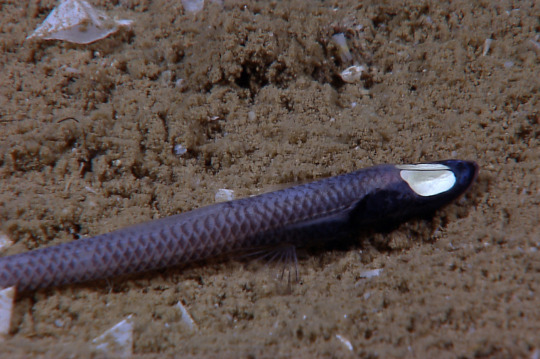
In place of eyes, the fish of this genus have large, flattened pale "plaques" on their face which sense light! One study found that larvae of these species have normal lens-having eyes, and so theorised that the developing fish go through a metamorphosis where their eyes become the plaques of adults.
#fish#fish facts#fishfact#fishblr#marine life#marine animals#marine biology#sea life#sea creatures#sea animals#deep sea life#deep sea fish#deep sea creatures#deep sea#biology#zoology#grideye
1K notes
·
View notes
Text
Idk about y’all but valentines memes have been my favorite part of the holiday since I was an inappropriately young child on the internet
So I made some cephalopod themed ones for your enjoyment <3






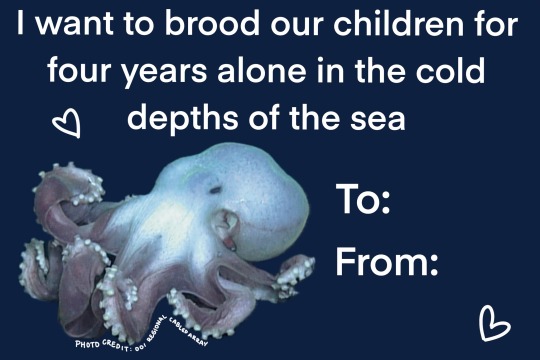



These puns are ones that did not make the cut for our actual Valentine’s Day cards shown in the last image
Purchase them at squidfacts.bigcartel.com <3
#cephalopods facts#cephalopod#cephalopods#squid#octopus#cuttlefish#nautilus#marine animals#marine biology#ocean animals#oceancore#ocean memes#marine memes#marine biology memes#valentines day#valentines cards#deep sea#marine biology shitpost
466 notes
·
View notes
Text





"Nautiluses are a living link to the ancient past.
They’ve been around over 480 million years, cruising deep ocean reefs even before the time of dinosaurs. These soft-bodied creatures live inside an intricately chambered shell.
A nautilus can only sense dark and light with its simple, pinhole-type eyes. But a nautilus can perceive water depth and current directions, as well as current speeds, to help it keep its body upright. A highly developed sense of smell helps a nautilus search for food and find mates."
Full article
- Monterey Bay Aquarium
#nautilus#fauna#monterey bay aquarium#original post#bio#biology#marine biology#bioscience#science#scienceblr#bioblr#molluscs#invertebrates#deep sea#deep sea creatures#fun facts#nature#infopost
2K notes
·
View notes
Text
this absolute icon

not only does she wear bright red lipstick she literally struts across the sea floor: red lipped batfish use their pectoral fins to 'walk' because they aren’t good swimmers.
#this is her world all of us just live in it#fish facts#fishblr#fish#marine animals#marine biology#marine life#aquatic life#red lipstick#red lipped batfish#deep sea creatures
272 notes
·
View notes
Text

thaumatichthys binghami aka wolf trap anglerfish my beloved 💛
#thaumatichthys binghami#wolf trap anglerfish#anglerfish#marine biology#fish#deep sea creatures#fun fact the wolftrap in the name comes from those big upper jaw flaps being able to swing shut over the lower jaw
3K notes
·
View notes
Text


Most sharks are negatively buoyant, meaning they naturally sink in water. However, in 2015, two deep sea sharks - the bluntnose sixgill shark (top) and the prickly shark (bottom) - were discovered to be positively buoyant, meaning they naturally float in water.
This could have one of two purposes: aiding stealth hunting by enabling them to ambush prey from below by motionlessly rising towards them; or for migrating to warmer waters closer to the surface at night to warm up the muscles (to then actively swim back down to colder waters during the day).
#marine animals#marine biology#shark#sharks#shark facts#fish facts#sharkblr#fish#fun facts#science#deep sea#bluntnose sixgill shark#prickly shark#deep sea fish
315 notes
·
View notes
Text
🐠 Daily Fish Fact: 🐠
The Oarfish is the longest bony fish alive, growing up to 56ft in length. Their rarity and large size, along with occasional beachings of oarfish after storms, and their habit of lingering at the surface when sick or dying, make oarfish a probable source of many sea serpent tales.
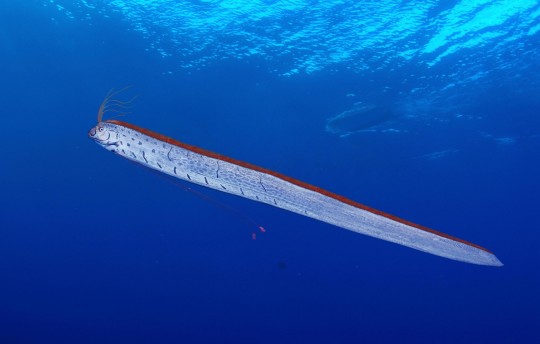
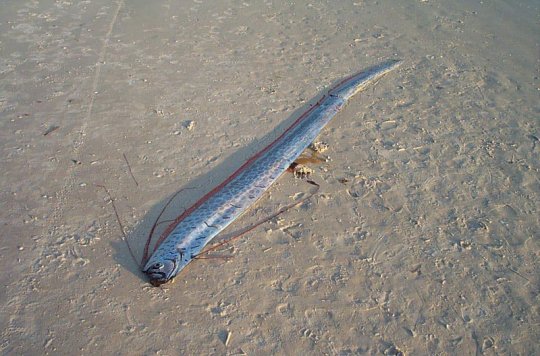
#oarfish#sea serpent?#long boi#rare fish#fish#ocean#marine#ocean life#marine life#marine animals#ocean animal#marine biology#respect the locals#fish facts#daily fish fact#daily fish#fish post#shark blog#deep sea#deep sea fish
303 notes
·
View notes
Text
Prompt 278
You know what I’ve gotten obsessed with and inspired by? Dredge.
You know what is also fun? Merfolk. What’s even better? Lovecraftian corrupted merfolk. Especially if say, one goes with the Lazarus Waters being a form of ectoplasm. So, in this? Lazarus waters are like lakes, while Amity Park, thanks to the Portal, and the barriers? It is an entire sea.
There are islands, small areas that were once the tips of buildings that have gathered more landmass around them. There are mangroves, trees not like anything on earth or anywhere else stretching up in canopies dark enough to block out the sun, yet lit by the green waters.
It goes deep. Mariana Trench deep, despite it being impossible. The GIW have explored for caves or tunnels, they’ve tried to find some sort of explanation, but there isn’t one.
Now all that ecto? That has an effect on people. They mutate, they change, they adapt. Anywhere else would have been a slow death- something the GIW might have even been counting on. But Amity Park? It was founded by witches, it was the hotspot for the supernatural, even before the Fentonwork Portal.
They’ve been dealing with this sort of energy in microdoses from the moment they first began to live in the city in any generation.
But they begin to adapt. Shift into something… other. Some stay contaminated, clinging to human forms as they form homes on the tiny islands, fishing and farming what they can. Others become Liminal, almost seeming to meld with fish, some similar to ones of the Living and others something just to the left. Similar yes, but not quite… right. And then there are those that have truly melded with the energy of the dead, forms torn asunder by it, ripped apart and made anew by it.
The first sign back when the barrier was activated, when they could no longer leave and were trapped were the fish in the lake. And now they are the same, with gazes of something Else, with gnashing teeth and a hunger gnawing at where hearts once were.
But they aren’t monsters. They’re still themselves. Just a little… Other now.
#DCxDP#DPxDC#Prompts#Eldritch Ghosts#Liminal Amity Park#Merfolk AU#They see nothing wrong with each other because they’ve gotten used to it#Also yes they can ‘swim’ in the air too#Seriously check out the Dredge Wiki if u aren’t up for playin- at least look at the Aberrations#Even the more human-looking Parkers (usually elderly but not always) still look Off#While others have become deep sea nightmares#I see the fact there’s an entire Lazarus ecosystem in the middle of nowhere Illinois interesting Absolutely No One#People Definitely Doesn’t Have A Fishing Boat Out There Trying To Fish Up The Pit Creatures#Honestly GIW might do that too & have some fucked up fish- they keep failing at catching a parker who knows better#Clockwork and others visit too sometimes & it’s like seeing a Fucking Incomprehensible Leviathan#If the Infinite Realms is the Open Ocean then Amity is a Sea where whales go to set up their nursery#Idk if any of this makes sense I’ve been sick the last few days lol#Dredge Au
164 notes
·
View notes
Text
DYK… (part 2)

tiger sharks are one of the shark species most likely to attack a human unprovoked, and is considered one of the most dangerous sharks in the world for that reason.
tiger sharks are one of the "Big Three" aggressive shark species, along with great white sharks and bull sharks.
tiger sharks are apex predators meaning they don't have many natural predators. In fact one of the only known predators to this species are humans and killer whales. A killer whale is much larger in size and weight, which allows it to overpower the shark.
#shark#marine biology#sharks#ocean#sea#aquatic#sea creatures#marine life#sealife#water#deep sea facts#sea salt#coast#waves#seaside#water life#sea animals#marine animals#deep sea#deep sea life#animal#nature#marine animal#ocean lover#ocean view#ocean life#underwater#ocean aesthetic#ocean facts#shark facts
92 notes
·
View notes
Text
W h a l e f a l l
C.W: Whale corpses

When a whale carcass floats down to the ocean floor in the abyssal zone, it creates an ecosystem called a 'whalefall', where a variety of deep marine life can live and be sustained for over 50 years.
This ecosystem has 4 stages:
Mobile Scavengers Stage

The first stage is when scavengers from around the plain gather to feast on the whales flesh - Typically by hagfish and sleeper sharks - until there is just bone.
This stage can last for months or up to 1.5 years.
Enrichment Opportunists Stage

This stage is when smaller scavengers - such as octopuses, crustaceans and molluscs - gather around the whale looking for tissue and bits of carcass left over from the first stage. This is also when osedax (boneworms) arrive and comsume the community of bacteria that eat the bone lipids.
This stage can last months or up to 5 years.
Sulfophilic Stage

In this stage the majority of scavengers have left and in its place are the boneworms and the community of chemosynthetic bacteria that break down the lipids in the bones and produces sulphide that can be consumed by other organisms like worms or shrimp.
This stage can last over 50 years.
Reef Stage

The final stage is when all the consumable material have been exhausted and the leftover bone creates a hard surface for abyssal filter feeders to latch onto. A 'reef' of sorts.
Whalefalls are one of many essential food-falls that sustain life at the bottom of the ocean, and are p cool i think anyway im done w my autism rant goodbye
#sorry i wasnt sure how to end it#marine#marine biology#marine life#oceancore#oceanology#oceanography#whales#whalefall#marine ecosystem#marine ecology#ecology#ecosystem#the abyssal#deep ocean#deep sea#science#science facts#fish#ocean floor#ocean#Sea floor#marine animals#seacore#pacific ocean#sailorcore#nautical#tw decay#tw corpse#ocean aesthetic
1K notes
·
View notes
Text
Fun isopod fact #22: isopods are great gamers and will beat you in fortnite
434 notes
·
View notes
Text
Daily fish fact #451
Wahoo!
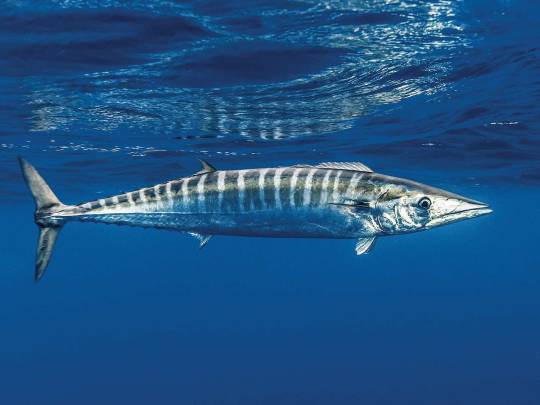
It is one of the fastest fish in the world, reaching speeds of 78 kph (48 mph)!
#the jokes write themselves!#also sorry no more streak of deep sea fish#fish#fishfact#fish facts#fishblr#marine biology#marine life#marine animals#sea creatures#sea animals#sea life#biology#zoology#wahoo fish#wahoo
3K notes
·
View notes
Text
I keep seeing these cute “guess the shark species” slideshows l on tiktok, but they always show a pelagic thresher shark and just call it a “thresher shark,” so I realized not a lot of people might know there are three species of thresher shark. I’m going to introduce you to all of them and give you some certified marine biologist (tm) tips and tricks to notice species-specific features to look for once you see the long tail that indicates it’s in Alopiidae (since even google images messes it up sometimes).
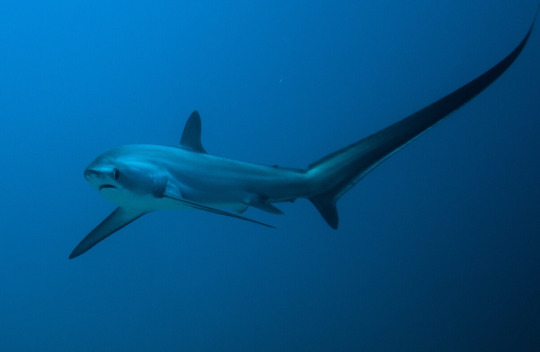
This is a pelagic thresher shark (Alopias pelagicus). It is the smallest of the three species, and usually the one everyone thinks of. Some of the most distinguishing features to me are the slender body shape, a smooth head with no noticeable ridge, and eyes that are still somewhat large, but not noticeably so. But the most important distinguisher to me is its coloration, the white on the shark’s ventral side forms a border with the grey on it’s dorsal side, and this border goes *under* the pectoral fins, not *over*. They can be found to at least 150 m.
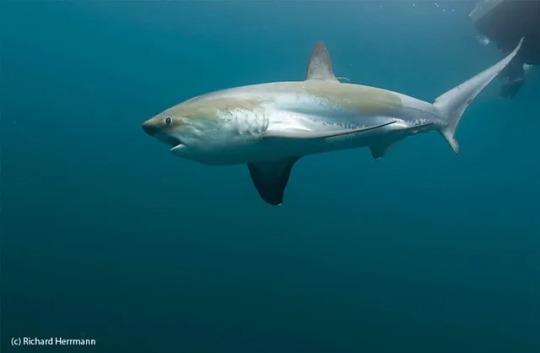
The common thresher shark (Alopias vulpinus) is the one that’s the most annoying to find on google images, because half the images are of the pelagic thresher. It is the largest species of thresher shark. As you can clearly see, these guys are a bit chunkier and also don’t have a noticeably large eye, and they have a smooth head that lacks a noticeable ridge. But the most important distinguisher for these guys is also related to their coloring. As you can kind of see in this photo, the border between the white of the ventral side and grey of the dorsal side goes well above the pectoral fin, so they have a spot of white that goes *above* their fin. This is the easiest way to distinguish them from pelagic thresher sharks, since you might see them within the same size range, so going off of body shape and size alone isn’t the most reliable.

And lastly, we have the bigeye thresher shark (Alopias superciliosus), so hopefully now it’s clear why I was harping on the eyes so much for the last two. Their gigantic uwu eyes are definitely a distinguishing feature, but the most prominent feature you want to look for during identification is the large ridge between the top of their head and their body. It’s super noticeable in person as well, and is not a feature shared by the other two sharks. These are the most easily distinguishable from the other two, and can be found to a depth of up to 723 m.
All thresher sharks are ovoviparous, so they give live birth! And they’re all cutie patooties who deserve to be appreciated.
#marine biology#thresher sharks#thresher shark#deep sea#sharks#shark facts#marine bio#woooo shawks :3#wittle guy#wittle baby
601 notes
·
View notes